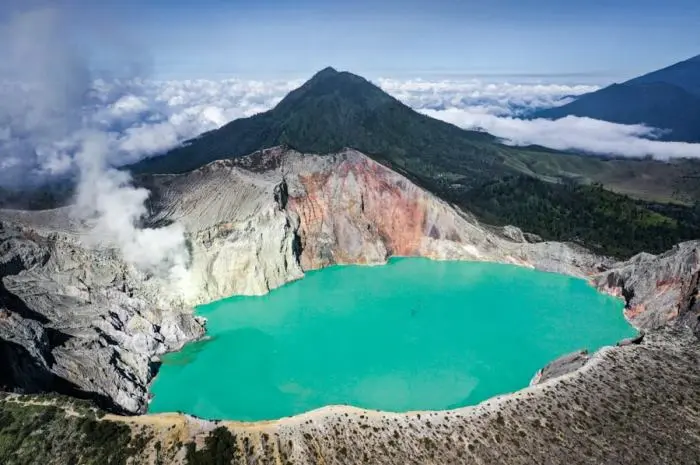
Located in the eastern part of Java, Indonesia, the Ijen Crater is a spectacular natural wonder situated in the Banyuwangi Regency. This volcanic crater, known locally as Kawah Ijen, is famous for its striking blue flames, acidic crater lake, and rugged, otherworldly landscapes. It’s a destination that attracts adventurers, nature lovers, and photographers from all around the world. In this article, we explore the breathtaking beauty of Ijen Crater, its unique features, and what makes it a must-visit for those seeking an extraordinary natural experience.
The Majestic Allure of Ijen Crater
A Volcanic Marvel
Ijen Crater is part of the Ijen volcano complex, a group of stratovolcanoes in East Java. The crater itself is approximately 2,600 meters above sea level. One of its most remarkable features is the large acidic crater lake, known for its striking turquoise color. The lake is highly acidic and rich in sulfur, creating a landscape that is both beautiful and surreal.
The Phenomenon of Blue Flames
One of the most unique and captivating sights at Ijen Crater is the natural phenomenon of blue flames. These flames are a result of the combustion of sulfuric gases that emerge from cracks in the volcano at high pressure and temperature. When they come in contact with the air, they ignite, creating an ethereal blue fire, which is particularly visible at night.
Experiencing Ijen Crater
The Trek to the Crater
The journey to Ijen Crater is an adventure in itself. Visitors typically start the trek in the early hours of the morning to reach the crater before dawn. The hike to the crater rim takes about 1-2 hours, and from there, it’s a steep descent to the lake’s edge. The path can be challenging, but the stunning views at sunrise make it a rewarding experience.
Witnessing the Sulphur Mining
Ijen Crater is also home to a traditional sulphur mining operation. Local miners extract sulphur from the crater and carry it up to 100 kilograms on their shoulders to the crater rim and down the mountain. Observing the miners at work is a humbling experience that offers insight into the harsh realities of this labor-intensive profession.
Safety and Precautions
Due to the toxic gases emitted by the volcano, safety precautions are a must. Visitors are advised to wear gas masks and follow the guidance of local guides. The conditions can be challenging, with uneven terrain and high concentrations of sulfur gas, so physical preparedness is important.
The Flora and Fauna around Ijen Crater
Surrounding the Ijen Crater are lush forests that are home to a variety of wildlife, including some endemic species. The contrast between the verdant forest and the barren volcanic landscape is striking.
Sustainable Tourism at Ijen Crater
Efforts are being made to promote sustainable tourism at Ijen Crater. This includes regulating the number of visitors, maintaining the natural environment, and supporting the local community, including the sulfur miners.
Conclusion
Ijen Crater in Banyuwangi offers an extraordinary natural experience that is both awe-inspiring and thought-provoking. From the stunning blue flames and acidic lake to the rugged beauty of the volcanic landscape and the resilience of the local sulfur miners, a visit to Rengganis Crater is an unforgettable adventure. It’s a stark reminder of the incredible power of nature and the endurance of the human spirit. As with any natural site, visitors should respect the environment and local communities, ensuring that this natural wonder can be enjoyed for generations to come.





